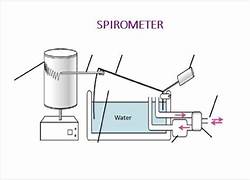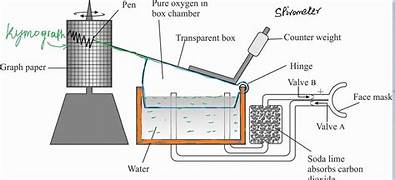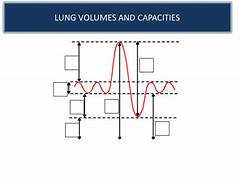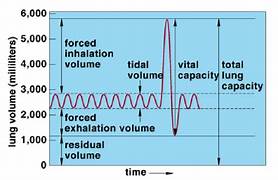exchange surfaces, gaseous exchange and ventilation in mammals and spirometer
1/50
There's no tags or description
Looks like no tags are added yet.
Name | Mastery | Learn | Test | Matching | Spaced |
|---|
No study sessions yet.
51 Terms
why do large multicellular organisms need a circulatory system
so oxygen can get to the middle of the body which is not possible with just diffusion through skin
to remove carbon dioxide
they have high metabolic rates so need to exchange lots of materials and fast
small surface area to volume ratio
features of an efficient gaseous exchange system
good blood supply and ventilation
thin epithelium
high surface area
features of alveoli
ventilation creates steep concentration gradient
blood capillaries to carry away oxygenated blood and maintain concentration gradient
one cell thick wall to decrease diffusion distance
fluid layer to maintain the shape of the air sacks so O2 and CO2 can pass through
what is surfactant and what does it do
thin layer of moisture lining alveoli
lost in evaporation as we breath out
produced by the lungs
reduces surface tension
stops alveoli walls from collapsing
thin barrier as an adaptation to increase diffusion distance
alveoli and capillary wall both one cell thick
both walls consist of squamous cells
capillaries in close contact with alveoli
narrow capillaries so red blood cells are squeezed against capillary walls
good blood supply as an adaptation to increase diffusion
helps maintain steep concentration gradient so gases continue to diffuse
transports co2 from tissue to lungs so the co2 conc is always higher in the blood than the air in the alveoli
transports o2 from lungs to tissues so o2 conc is always higher in the air of the alveoli than the blood
ventilation ensures these concentration gradients
ventilation
breathing movements ventilate the lungs replacing the used air with fresh air and bringing in more oxygen and removing carbon dioxide
inspiration
breathing in
expiration
breathing out
inspiration in mammals process
diaphragm contracts and flattens displacing the digestive organs downwards
external intercostal muscles contract to raise the ribs
volume of the chest cavity is increased
pressure in the chest cavity drops below atmospheric pressure
air rushes into the lungs down a pressure gradient
expiration in mammals process
diaphragm relaxes and is pushed up into a dome by the displaced organs below
external intercostal muscles relax and the ribs fall
internal intercostals can contract to help push out air more forcefully during exercise, coughing and sneezing
volume of the chest cavity decreases
pressure of the chest cavity increases above atmospheric pressure
air is forced out of the lungs
trachea diameter
1.8cm
trachea features
c shaped rings of cartilage
goblet cells
ciliated cells
smooth muscle
elastic fibres
why does the trachea have c shaped rings of cartilage
flexibility and space for oesophagus
bronchus diameter
1.2cm
bronchus features
o shaped rings or cartilage
goblet cells
ciliated cells
smooth muscle
elastic fibres
why do bronchi have o shaped rings of cartilage
stability
bronchiole diameter and how many present
1mm
48000 present in sytem
bronchiole features
goblet cells
ciliated cells
smooth muscle
squamous epithelium
elastic fibres
alveolus diameter and how many present
250 micrometres
3 billion present in system
alveolus features
squamous epithelium
elastic fibres
cartilage
irregular blocks that give strength and prevent collapsing during inspiration
smooth muscle
involuntarily constrict airways if harmful substances are in the air
prevent harmful substances entering alveoli and causing damage
elastic fibres
in alveolus walls so they can stretch during inspiration and recoil during expiration to help force the air out
goblet cells
release mucous to trap pathogens
ciliated epithelium
waft mucus up to the top of the airways to be swallowed or coughed out

labelled spirometer

what happens when you breath in from a spirometer
oxygen taken from the chamber and it sinks
what happens when you breath out form a spirometer
oxygen pushed into chamber and it floats

labelled spirometer trace

spirometer
a device that can measure the movement of air into and out of the lungs
these movements can be recorded on a kymograph
what is a data logger for a spirometer
picks up electric signals from a motion senser connected to the spirometer
what can the data logger of a spirometer give readings of
vital capacity
residual volume
tidal volume
breathing rate
oxygen uptake
vital capacity
maximum volume of air that can be expelled from the lungs after taking the deepest breath possible (2.5-5dm3)
residual volume
the volume of air remaining in the lungs after maximum exhalation (1.5dm3)
how to calculate total lung volume
residual volume + vital capacity = total lung volume
tidal volume
volume of air inhaled or exhaled in one breath at rest (0.5dm3)
breathing rate
number of breaths per minute
oxygen uptake
volume of oxygen absorbed by the lungs in one minute
why do males have higher vital capacities
typically larger than females and have more of a need for oxygen to reach cells
why do athletes have higher vital capacities
they regularly reach their vital capacities during exercise making the elastic tissue stretchier and intercostals and diaphragm stronger
factors affecting vital capacity
size of the person (particularly height)
age and gender
level of regular exercise
why does a spirometer use sodalime
toxic carbon dioxide would accumulate if someone is constantly breathing in and out the same air
soda lime absorbs co2 that is exhaled
how can the oxygen uptake from a spirometer be calculated with the help of sodalime
as co2 is removed the volume if the gas in the spirometer will decrease
co2 breathed out is equal to the volume of o2 used up by the person
so o2 uptake can be calculated
calculation for oxygen uptake
reduction in chamber x 60 seconds / time taken for reduction
factors affecting lung capacity readings
wearing a nose clip or holding nose to ensure you only breath in and out through your mouth
peakflow meters
measure how hard and fast you exhale
puff bags
measure tidal volume and vital capacity
how to calculate surface area to volume ratio
divide the surface area by the volume
explaining how a spirometer works
oxygen filled chamber with moveable lid
person breaths through a tube connected to the oxygen chamber
lid moves up and down as the person breaths in and out
movements recorded by a pen attached to the lid of the chamber on a rotating drum making a spirometer trace